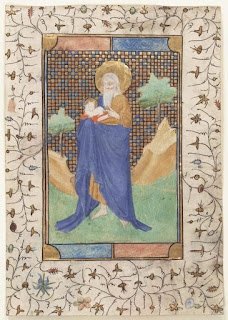Leaves from a Book of Hours Repurposed as an Armorial
As you can see from the title and description, the author believes that the vellum of the miniatures was re-purposed to create an armorial. But for several reasons I think it is the other way around. As I wrote in the comments section,
Author: "It is on a leaf that was originally blank on the other side, and was thus doubtless the verso of single-leaf miniature...
Author: "Very strangely, the blank recto was later used for drawing the arms of various English families..."
Me: "Would you consider it possible that the opposite is true: That someone was re-purposing the blank sides of the leaves of an existing book of heraldry? Because,
"The extent to which the shields are cropped at the sides and at the bottom give an idea of how much wider the margins of the miniatures originally were..."
... perhaps a later miniature artist was unconcerned with the coats of arms images, and was more interested in trimming their miniatures, for formatting or framing?"

I didn't want to suggest "forgery" in those comments, only my reversal of the suggested order of production. One thing at a time. But the thing is, first of all, miniatures would be quite saleable, while an book of heraldry, not so much. It was (and is?) common practice for forgers to use available old materials to create their works, and finding a book of heraldry would be a mother lode of blank vellum. The facts that the heraldry was what got trimmed down improperly, and that these leaves were separated, both also imply the miniatures came second. I mean, if one re-purposed the miniatures into an armorial, then why was the armorial not kept together? It would have to be: Collect miniatures, paint heraldry, take apart again, trim heraldry to ruin it in order to bring up the importance of the miniatures... again.
If I am correct as to the order, I also don't think these are authentic. Not from an art-history or stylistic standpoint (I can only judge them as forgeries intuitively), but from the circumstances. It was a very common practice to find old materials to forge miniatures on; while genuine miniatures are usually found in the context of a text which describes them. These do no have that. There is NO context. It was not, to my knowledge, a practice to make individual, decorative miniatures for display... nor fill a book with them. For forgeries, it was VERY common. Just looking at the vast corpus of the Spanish Forger alone... numbering at least 200 plus works to date... their practice was just this: Re-purpose leaves from missals and other sources, to produce colorful and exciting medieval scenes, which would easily sell.

Above: A work by the Spanish Forger, on a re-purposed (and less valuable, but genuine) page from a choir book.
So if both my above points are correct, this brings us to the seller, WMV, and more importantly, the blog author's noting,
So I am going to make a third suggestion here, a further speculation, based on my previous two: Voynich was, and would have full well known that he was, selling forged miniatures."Of about a dozen catalogues I looked at, none seemed to include medieval manuscripts, although he claimed to have them in stock, in both his London and Paris locations, including "Single Miniatures on Vellum"